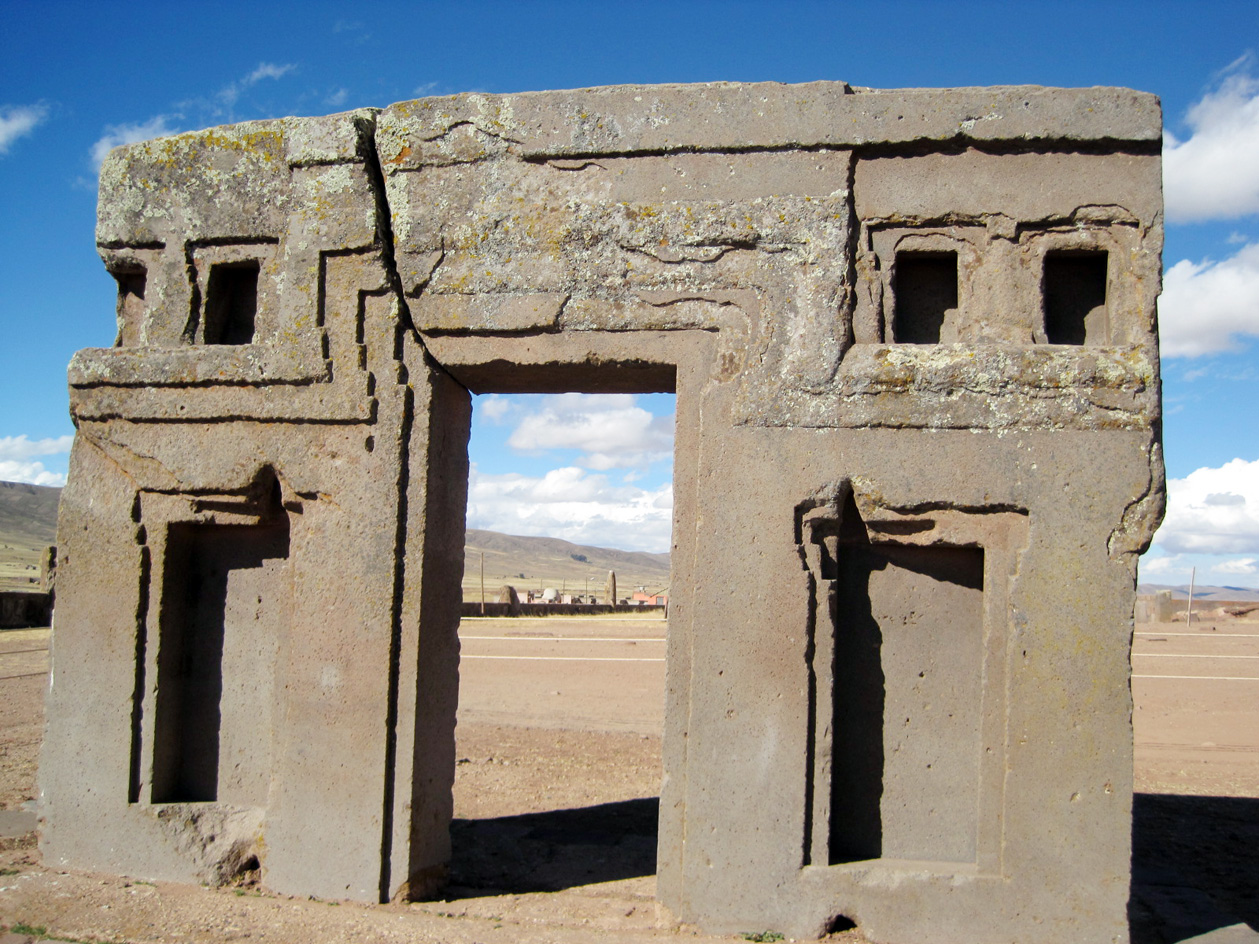
4.2.9.1 Tiiwanaku, an introduction Humanities LibreTexts
Tiwanaku (or Tiahuanaco) was the capital of the Tiwanaku empire between c. 200 - 1000 CE and is situated in the Titicaca basin. At an altitude of 3,850 metres (12,600 ft) it was the highest city in the ancient world and had a peak population of between 30,000 and 70,000 residents.

"the gate of the sun", a stone gateway constructed by the Tiwanaku
Gateway of the Sun, Tiwanaku Illustration by Dennis Jarvis published on 14 March 2014 Download Full Size Image The Gateway of the Sun in Tiwanaku (Tiahuanaco), Bolivia. Carved from a single massive block of andesite stone, the Gateway is 2.8 metres high and 3.8 metres wide. The opening in the gate is 1.4 metres wide.

The Puerta de Sol (Gateway of the Sun) of the Kalasasaya, at the
Structures Carving in the Gate of the Sun of Tiwanaku, litography of 1903. The structures that have been excavated by researchers at Tiwanaku include the terraced platform mound Akapana, Akapana East, and Pumapunku stepped platforms, the Kalasasaya, the Kantatallita temple, the Kheri Kala, and Putuni enclosures, and the Semi-Subterranean Temple.

Gateway of the sun in Tiwanaku. Tiwanaku (Spanish Tiahuanaco and
Gateway of the Sun , a monolithic portal carved out of a single block of andesite. The monument was discovered in the city's main courtyard and may have originally served as the portal to the Puma Punku, one of the city's most important public shrines. The Gateway contains low relief carvings across the lintel set into a square grid.

gate of Sun at Tiwanaku Ancient, Modern history, Stone city
Perhaps one of the most iconic works of Tiwanaku public architecture is the Gateway of the Sun, a monolithic portal carved out of a single block of andesite. The monument was discovered in the city's main courtyard and may have originally served as the portal to the Puma Punku, one of the city's most important public shrines.

Gate of the Sun at Tiwanaku Mira Terra Images Travel Photography
The Monolithic Gate of the Sun at Tiahuanaco in Bolivia, drawn by Ephraim Squier in 1877. (Public domain) The Discovery of the Tiahuanaco Sun Gate The site of Tiahuanaco in Bolivia was first recorded in 1549 by Pedro Cieza de León.

Tiwanaku, the lost Andean civilisation capital Batnomad
The Gate of the Sun, also known as the Gateway of the Sun, is a monolith carved in the form of an arch or gateway at the site of Tiahuanaco by the Tiwanaku culture, an Andean civilization of Bolivia that thrived around Lake Titicaca in the Andes of western South America around 500-950 AD. [1]

Gateway of the Sun, Tiwanaku (Illustration) Ancient History Encyclopedia
Illustration. by Flickruser: mishmoshimoshi. published on 16 March 2014. Download Full Size Image. The monumental stepped entrance to the sacred Kalasasaya precinct at Tiwanaku, Bolivia, c. 300 CE. Framed by the sandstone portal is one of the huge stone statues found at the site. Remove Ads.

Tiwanaku Inca Empire of the Sun Pinterest Inca empire
The origins of Tiwanaku are shrouded in the mists of time. Archaeological evidence suggests that the site was initially inhabited around 1500 BCE, with the city reaching its zenith between 500 and 900 CE. During this period, Tiwanaku was the center of a powerful state that exerted influence over a large portion of the Central Andes and beyond.

Gateway of the Sun in Tiwanaku Stock Photo Image of andes, gateway
Posnansky presented his interpretation of Tiwanaku's calendars as a response to the debates of the World Calendar Movement, which in the 1930s was attempting to rationalize the Gregorian calendar. In the Gateway, Posnansky found a uniquely Bolivian response to the international, North Atlantic-dominated scientific community's search for a rational way to keep time in the world economy.

Gateway Of The Sun, Tiwanaku, Bolivia Photograph by Aidan Moran Pixels
The Gate of the Sun holds immense cultural and religious significance to the Tiwanaku civilization, one of the most influential pre-Columbian cultures in the Andean region. It is believed to have been part of a larger ceremonial complex and served as an entrance gate to the sacred area of Tiwanaku. The central figure, often interpreted as a.

The Puerta de Sol (Gateway of the Sun) of the Kalasasaya, at the
feature of Tiwanaku In Tiwanaku.the Kalasasaya is the monolithic Gateway of the Sun, which is adorned with the carved central figure of a staff-carrying Doorway God and other subsidiary figures, sometimes referred to as angels or winged messengers. A great number of freestanding carved stone figures have also been found at the site.

Gateway Of The Sun Photograph by Steve Allen/science Photo Library
The Gate of the Sun, one of the most famed remnants left by the Tiwanaku, a pre-Columbian polity based in the city of Tiwanaku in western Bolivia. Author: Dennis Jarvis, CC BY-SA 2.0 Temples and structures can be traced back to various periods.

Gateway of the Sun, Tiwanaku, Bolivia, ca. 375700 CE. Stone, 9'10 high
Today, Tiwanaku is a popular tourist site and a UNESCO World Heritage site. Visitor can view its many monuments, gates - such as the well-known Gateway of the Sun - and statues, all of which attest to the importance of this once ceremonial city. Tiwanaku today. The site has remarkably well preserved carvings, and is often extremely quiet.

The Gateway of the Sun (Puerta del Sol), the Kalasasaya Temple at 3,870
Gateway of the Sun Figure \(\PageIndex{3}\): Sun Gate, Tiwanaku, Bolivia (photo: Brent Barrett, CC BY-NC-ND 2.0). View in Google Street View. The people of Tiwanaku were skilled engineers and masons, producing impressive stone buildings and monuments. Perhaps one of the most iconic works of Tiwanaku public architecture is the Gateway of the Sun.

Kalasasaya Sun Gate, Tiahuanaco
Find Deals on Hotels in Tiwanaku. Browse Reviews from Aussie Travellers. Amazing Range of Accommodations. Compare and Book Securely Today.
